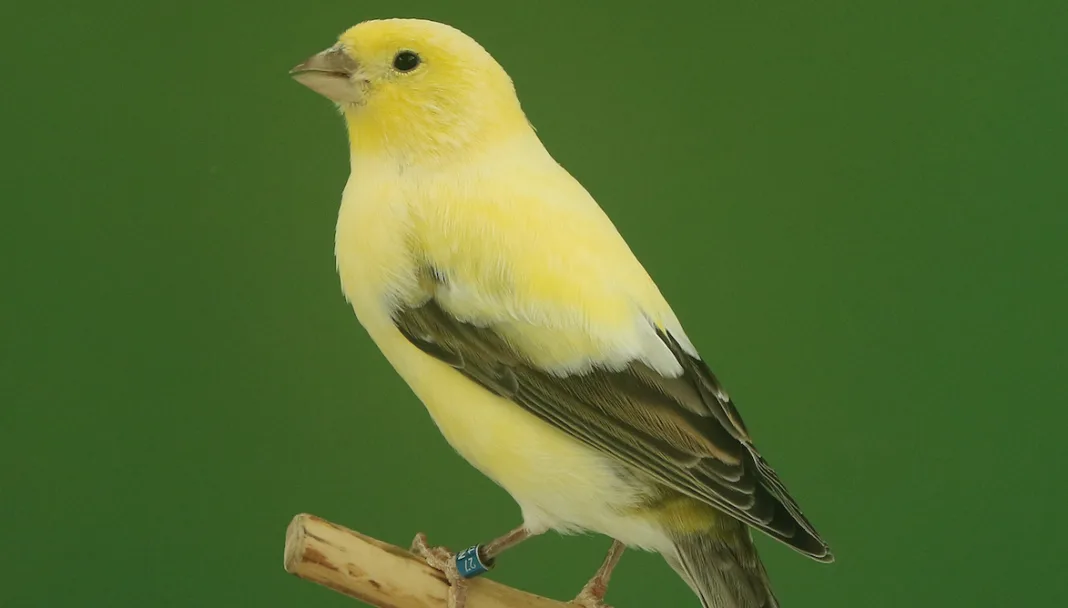This enigmatic, recently resurrected canary continues to provoke both puzzlement and controversy among breeders. Yet in fact its distinctive mutation is far from unique in the avian world. HEIN VAN GROUW explains the key process known as ‘progressive greying’ (part 1)
THE London fancy is an iconic breed of canary. It is distinguished by the absence of melanin in its body feathers, resulting in yellow plumage due to the presence of carotenoid alone, but with still fully melanised flight and tail feathers.
It is unknown when exactly the first London fancy canaries appeared, as nothing can be found with certainty in the old, 19th-century literature, but they were certainly already present at the beginning of the 1800s, as can be seen in the 1824 book A practical Treatise on British Song Birds by Joseph Nash. The London fancy most likely originated as a mutation within the Lizard canary, which at the time was the most kept breed of canary in the British capital.
However, London fancies have always been rare – it was estimated in the mid-1870s that there were probably fewer than 100 birds in existence – and were expensive to very expensive, so they were only available to a few. Possibly these more well-off fanciers kept the prices artificially high, but the fact is that the prizes to be won at shows with a London fancy were also higher than with any other canary breed.
At the great show at Crystal Palace in 1858, for example, two prizes were available for each canary breed in each class, and the first prize per class was £1. However, for the London fancies three prizes were available, and the first prize was £2. (This was equivalent to a week’s wage for a building craftsman at the time.)
For several reasons (e.g. a limited gene pool and competition from new varieties, to name a few), in the late 1800s the London fancy became even more rare. In an attempt to rescue the breed, fanciers crossed them with Lizards and other varieties. In these later birds, some melanin-pigmented feathers often remained after the first moult (spanglebacks). That was blamed on the outcrossing with other breeds and some suspected that the classic London fancy with its perfect markings had been lost. However, the illustrations in Nash (1824) show that spanglebacks were also present in the “good old days”.
The difference in the remaining melanin pigment between spangleback and a London fancy with a classic pattern is more likely the result of the nature of the inheritance of the mutation. Today, prominent names in the canary fancy, such as Andy Early and Huw Evans, are working on unravelling the genetics of the mutation that causes the typical pattern in the London fancy.
The original bird is lost
As a breed, the London fancy had nearly disappeared in the early 1900s, and it seems that the last stud of pure-bred London fancy canaries was destroyed in a bombing raid during World War II (information provided by Huw Evans). Breeders ever since have unsuccessfully tried to recreate the London fancy with variegated canaries. Unsuccessfully, because the pattern was not caused by leucism (a common mutation in the canary, which gives rise to the variegated patterns) but by a mutation called progressive greying.
London fancy canaries are fully melanin-pigmented when juvenile, but the loss of melanin-producing cells starts almost immediately after the bird has developed this plumage. Hence, after its first moult the new feathers lack melanin. Canaries, like most passerines, do not moult their flight and tail feathers in their first year, so the typical pattern of the London fancy is the result of adult feathers (without melanin) and the still-present juvenile feathers (with melanin). This pattern will last until the second moult, when the juvenile wing and tail feather will be replaced. Subsequently, many London fancies will lose yet more melanin and after several years some become almost all yellow, with hardly any or no melanin left.
Canary breeders during the 1800s knew this, but their counterparts in the 20th century did not. To recreate the breed was impossible without the particular mutation that caused progressive melanin-cell loss, and that seemingly disappeared with the London fancy from canary aviculture. At least, it had disappeared within the Lizard. However, in other breeds, the mutation seems to have persisted without being noticed as such.
From my own experience, we know that a form of progressive greying can be present in the Irish fancy. I noticed that some of the young birds that left the nest with variegated (leucistic) plumage lost all their melanin-pigmented body feathers after the first moult. The melanised juvenile wing feathers also returned without pigment after the subsequent moult and the entire bird was then yellow.
Continues next week.
● Many thanks to Huw Evans who kindly shared his knowledge regarding the history of the London fancy canary.
Hein van Grouw is the senior curator of birds at the Natural History Museum at Tring, Hertfordshire.
Find more news and articles like this on the Cage & Aviary Birds website. Subscribe to Cage & Aviary Birds magazine now.


